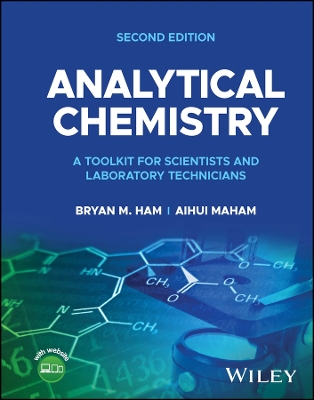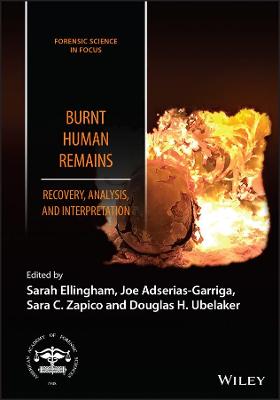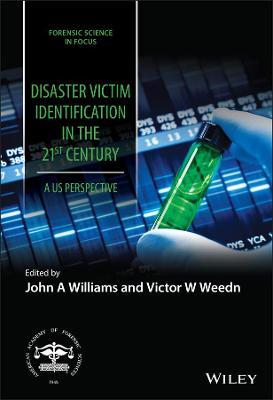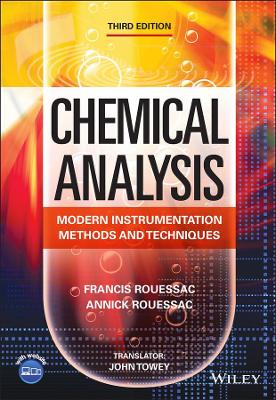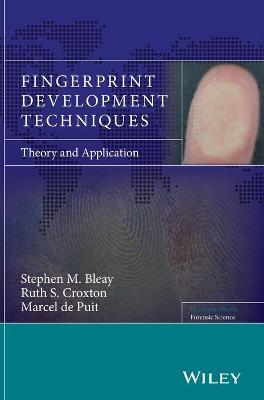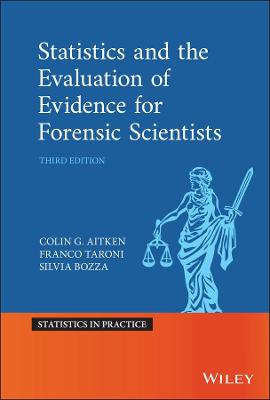Stable Isotope Forensics
 -15%
portes grátis
-15%
portes grátis
Stable Isotope Forensics
Methods and Forensic Applications of Stable Isotope Analysis
Meier-Augenstein, Wolfram
John Wiley & Sons Inc
12/2017
512
Dura
Inglês
9781119080206
15 a 20 dias
990
Foreword: Dame Sue Black xiii
Foreword: Mark Harrison xv
Foreword to the 1st Edition xvii
Book Endorsements xix
Preface to the 2nd Edition xxi
List of Abbreviations xxv
About the Companion Website xxvii
Introduction: Stable Isotope 'Profiling' or Chemical 'DNA':
A New Dawn for Forensic Chemistry? xxix
I How it Works 1
I.1 What are Stable Isotopes? 2
I.2 Natural Abundance Variation of Stable Isotopes 4
I.3 Chemically Identical and Yet Not the Same 12
I.4 Isotope Effects, Mass Discrimination and Isotopic Fractionation 15
I.4.1 Physical Chemistry Background 15
I.4.2 Fractionation Factor ? and Enrichment Factor ? 17
I.4.3 Isotopic Fractionation in Rayleigh Processes 19
I.4.3.1 Isotopic Fractionation Summary 20
I.5 Stable Isotopic Distribution and Isotopic Fractionation of Light Elements in Nature 22
I.5.1 Hydrogen 22
I.5.2 Oxygen 26
I.5.3 Carbon 27
I.5.4 Nitrogen 30
I.5.5 Sulfur 32
I.5.6 Isoscapes 35
I.6 Stable Isotope Forensics in Everyday Life 40
I.6.1 "Food Forensics" 42
I.6.1.1 Authenticity and Provenance of Single-Seed Vegetable Oils 42
I.6.1.2 Authenticity and Provenance of Beverages 45
I.6.1.3 Caveats 49
I.6.2 Authenticity and Provenance of other Premium Products 53
I.6.3 Counterfeit Pharmaceuticals 54
I.6.4 Environmental Forensics 59
I.6.5 Wildlife Forensics 61
I.6.6 Anti-Doping Control 62
I.7 Summary of Part I 65
References Part I 67
II Instrumentation, Analytical Techniques and Data Quality 81
II.1 Mass Spectrometry versus Isotope Ratio Mass Spectrometry 82
II.1.1 Stability, Isotopic Linearity and Isotopic Calibration 85
II.2 Instrumentation for Stable Isotope Analysis 90
II.2.1 Dual-Inlet IRMS Systems 92
II.2.2 Continuous-Flow IRMS Systems 93
II.2.3 Bulk Material Stable Isotope Analysis 94
II.2.3.1 13C, 15N and 34S 94
II.2.3.2 2H and 18O 96
II.2.4 Compound-Specific Stable Isotope Analysis of Volatile Organic Compounds 98
II.2.4.1 Compound-Specific 13C or 15N Analysis by GC/C-IRMS 98
II.2.4.2 Compound-Specific 2H or 18O Analysis by GC/HTC-IRMS 100
II.2.4.3 Position-Specific Isotope Analysis 101
II.2.5 Compound-Specific 13C/15N Analysis of Polar, Non-Volatile Organic Compounds by LC-IRMS 101
II.2.6 Compound-Specific Isotope Analysis and Forensic Compound Identification 103
II.3 Quality Control and Quality Assurance in Continuous-Flow Isotope Ratio Mass Spectrometry 106
II.3.1 Compliance with IUPAC Guidelines is a Prerequisite not a Luxury 106
II.3.2 The Identical Treatment Principle 111
II.3.3 The Importance of Scale Normalization 112
II.3.3.1 Scale Normalization of Measured ?2H Values to VSMOW 114
II.3.3.2 Scale Normalization of Measured ?13C Values to VPDB 120
II.3.3.3 Scale Normalization of Measured ?18O Values to VSMOW 122
II.3.3.4 Scale Normalization of Measured ?15N Values to Air 126
II.3.3.5 Scale Normalization of Measured ?34S Values to VCDT 127
II.4 Points of Note for Stable Isotope Analysis 128
II.4.1 Preparing for Analysis 128
II.4.2 Generic Considerations for BSIA 131
II.4.2.1 Scale Normalization of BSIA 132
II.4.2.2 Keeping Your Powder Dry 134
II.4.2.3 Isobaric Interference 135
II.4.2.4 Ionization Quench Effect 137
II.4.3 Particular Considerations for BSIA 140
II.4.3.1 Bulk 15N Analysis of Nitrates 140
II.4.3.2 Bulk 2H Analysis of Nitrogen-Rich Compounds 141
II.4.3.3 Total ?2H versus True ?2H Values 141
II.4.3.4 Organic Compounds with Exchangeable Hydrogen and Implications for 2H Abundance Analysis 144
II.4.3.4.1 Chemical and Biochemical Considerations - Example: Hair 152
II.4.3.5 2H Analysis of Human Hair 158
II.4.3.5.1 Two-Point Equilibration with Water at Ambient Temperature 161
II.4.3.5.2 Two-Point End-Member Comparative Equilibration 166
II.4.3.5.3 On-Line Two-Point End-Member Comparative Steam Equilibration 170
II.4.4 Points of Note for CSIA 172
II.4.4.1 Scale Normalization of GC-IRMS Analyses 172
II.4.4.2 Isotope Effects in GC-IRMS during Sample Injection 175
II.4.4.3 The Chromatographic Isotope Effect in GC-IRMS 176
II.4.4.4 Derivatization of Polar Compounds for GC-IRMS 178
II.4.4.5 Compound-Specific 2H Analysis of N- or Cl-Rich Compounds 181
II.5 Statistical Analysis of Stable Isotope Data within a Forensic Context 183
II.5.1 Chemometric Analysis 183
II.5.2 Bayesian Analysis 185
II.6 Quality Control and Quality Assurance in Forensic Stable Isotope Analysis 194
II.6.1 Accreditation to ISO 17025 195
II.6.1.1 Who Assesses the Assessors? 197
II.6.2 The Forensic Isotope Ratio Mass Spectrometry Network 205
II.7 Summary of Part II 207
II.A How to Set Up a Laboratory for Continuous-Flow Isotope Ratio Mass Spectrometry 209
II.A.1 Pre-Installation Requirements 210
II.A.2 Laboratory Location 210
II.A.3 Temperature Control 211
II.A.4 Power Supply 212
II.A.5 Gas Supply 213
II.A.6 Forensic Laboratory Considerations 216
II.A.7 Finishing Touches 217
II.B Sources of International Reference Materials and Tertiary Standards 219
II.C Selected Sample Preparation Protocols 220
II.C.1 Derivatization of Amino Acids for Compound Specific Isotope Analysis by GC-IRMS 220
II.C.2 Acid Digest of Carbonate from Bio-apatite for 13C and 18O Analysis 223
II.C.3 Preparing Silver Phosphate from Bio-apatite for 18O Analysis 225
II.C.4 Two-Point Water Equilibration Protocol for Determination of Non-ex ?2H Values of Human Hair 227
II.D Internet Sources of Guidance and Policy Documents 231
References Part II 233
III Stable Isotope Forensics: Case Studies and Current Research 247
III.1 Forensic Context 248
III.1.1 Legal Context 249
III.2 Distinguishing Drugs 255
III.2.1 Natural and Semisynthetic Drugs 255
III.2.1.1 Marijuana 255
III.2.1.2 Morphine and Heroin 257
III.2.1.3 Cocaine 259
III.2.2 Synthetic Drugs 263
III.2.2.1 Amphetamines 263
III.2.2.2 Methamphetamine: Synthesis and Isotopic Signature 264
III.2.2.2.1 Two Different Synthetic Routes - Clandestine Conditions 268
III.2.2.3 MDMA: Synthesis and Isotopic Signature 270
III.2.2.3.1 Three Different Synthetic Routes - Controlled Conditions 273
III.2.2.3.2 One Synthetic Route - Variable Conditions 279
III.2.3 "Legal Highs" and "Designer Drugs" 284
III.2.3.1 Mephedrone 284
III.2.3.2 Piperazines 287
III.2.4 Excipients 291
III.2.5 Conclusions 293
III.3 Elucidating Explosives 296
III.3.1 Stable Isotope Analysis of Explosives and Precursors 297
III.3.1.1 Ammonium Nitrate (AN) 298
III.3.1.2 Hexamine, RDX, C4 and Semtex 300
III.3.1.3 Isotopic Product/Precursor Relationship 305
III.3.1.3.1 RDX and HMX 305
III.3.1.3.2 HMTD and TATP 309
III.3.1.4 Hydrogen Peroxide 315
III.3.2 Potential Pitfalls 321
III.3.3 Conclusions 323
III.4 Matching Matchsticks 324
III.4.1 13C-Bulk Isotope Analysis 325
III.4.2 18O-Bulk Isotope Analysis 326
III.4.3 2H-Bulk Isotope Analysis 328
III.4.4 Matching Matches from Fire Scenes 330
III.4.5 Conclusions 331
III.5 Provenancing People 333
III.5.1 Stable Isotope Abundance Variation in Human Tissue 336
III.5.1.1 Hair and Nails 338
III.5.1.1.1 Characteristics of Hair 340
III.5.1.1.2 Characteristics of Nails 342
III.5.1.1.3 Diagenetic Changes of Keratin 342
III.5.1.1.4 2H Isotopic Record in Hair and Nail 343
III.5.1.1.5 18O Isotopic Record in Hair and Nail 345
III.5.1.1.6 13C Isotopic Record in Hair and Nail 346
III.5.1.1.7 15N Isotopic Record in Hair and Nail 347
III.5.1.2 Bone and Teeth 350
III.5.1.2.1 Chemical Composition of Bone and Teeth 351
III.5.1.2.2 Static versus Remodelling Tissue Compartments 352
III.5.1.2.3 Diagenetic Changes of Bone and Teeth Mineral 354
III.5.1.2.4 Diagenetic Changes of Type I Collagen 356
III.5.1.2.5 18O Isotopic Record in Carbonate and Phosphate from Bio-apatite 357
III.5.1.2.6 13C Isotopic Record in Carbonate from Bio-apatite 363
III.5.1.2.7 Isotopic Record in Type I Collagen 364
III.5.1.3 Trophic Level Shift Effect on Stable Isotope Abundance Values in Human Tissue 365
III.5.2 Case Examples 370
III.5.2.1 The Skull from the Sea 371
III.5.2.2 A Human Life Recorded in Hair 375
III.5.2.3 Found in Newfoundland 379
III.5.2.4 The Case of "The Scissor Sisters" 384
III.5.2.5 Too Short a Life 390
III.5.2.6 Saltair Sally 393
III.5.2.7 A Tale of Two Cultures 394
III.5.3 Conclusions and Caveats 397
III.6 Stable Isotope Forensics of Other Physical Evidence 401
III.6.1 Microbial Isotope Forensics 402
III.6.2 Toxins and Poisons 404
III.6.3 Paper, Plastic (Bags) and Parcel Tape 404
III.6.3.1 Paper 404
III.6.3.2 Plastic and Plastic Bags 407
III.6.3.3 Parcel Tape 408
III.6.4 Conclusions 412
III.7 Evaluative Interpretation of Forensic Stable Isotope Data 413
III.7.1 Not Scale Referenced ?-Values 415
III.7.2 Unresolved Contradictory Data 418
III.7.2.1 Example: "Geographic Provenance of a Murder Victim" 418
III.7.2.2 Example: "Manslaughter due to Negligence" 420
III.7.3 Foregone Conclusions 422
III.7.4 Logical Fallacies 424
III.7.5 Untested Assumptions 426
III.7.6 Conclusion 428
III.8 Summary of Part III 430
III.A An Abridged List of Forensic Stable Isotope Laboratories Worldwide 432
References Part III 434
Recommended Reading 453
Author's Biography 459
Acknowledgements 461
Index 463
Foreword: Dame Sue Black xiii
Foreword: Mark Harrison xv
Foreword to the 1st Edition xvii
Book Endorsements xix
Preface to the 2nd Edition xxi
List of Abbreviations xxv
About the Companion Website xxvii
Introduction: Stable Isotope 'Profiling' or Chemical 'DNA':
A New Dawn for Forensic Chemistry? xxix
I How it Works 1
I.1 What are Stable Isotopes? 2
I.2 Natural Abundance Variation of Stable Isotopes 4
I.3 Chemically Identical and Yet Not the Same 12
I.4 Isotope Effects, Mass Discrimination and Isotopic Fractionation 15
I.4.1 Physical Chemistry Background 15
I.4.2 Fractionation Factor ? and Enrichment Factor ? 17
I.4.3 Isotopic Fractionation in Rayleigh Processes 19
I.4.3.1 Isotopic Fractionation Summary 20
I.5 Stable Isotopic Distribution and Isotopic Fractionation of Light Elements in Nature 22
I.5.1 Hydrogen 22
I.5.2 Oxygen 26
I.5.3 Carbon 27
I.5.4 Nitrogen 30
I.5.5 Sulfur 32
I.5.6 Isoscapes 35
I.6 Stable Isotope Forensics in Everyday Life 40
I.6.1 "Food Forensics" 42
I.6.1.1 Authenticity and Provenance of Single-Seed Vegetable Oils 42
I.6.1.2 Authenticity and Provenance of Beverages 45
I.6.1.3 Caveats 49
I.6.2 Authenticity and Provenance of other Premium Products 53
I.6.3 Counterfeit Pharmaceuticals 54
I.6.4 Environmental Forensics 59
I.6.5 Wildlife Forensics 61
I.6.6 Anti-Doping Control 62
I.7 Summary of Part I 65
References Part I 67
II Instrumentation, Analytical Techniques and Data Quality 81
II.1 Mass Spectrometry versus Isotope Ratio Mass Spectrometry 82
II.1.1 Stability, Isotopic Linearity and Isotopic Calibration 85
II.2 Instrumentation for Stable Isotope Analysis 90
II.2.1 Dual-Inlet IRMS Systems 92
II.2.2 Continuous-Flow IRMS Systems 93
II.2.3 Bulk Material Stable Isotope Analysis 94
II.2.3.1 13C, 15N and 34S 94
II.2.3.2 2H and 18O 96
II.2.4 Compound-Specific Stable Isotope Analysis of Volatile Organic Compounds 98
II.2.4.1 Compound-Specific 13C or 15N Analysis by GC/C-IRMS 98
II.2.4.2 Compound-Specific 2H or 18O Analysis by GC/HTC-IRMS 100
II.2.4.3 Position-Specific Isotope Analysis 101
II.2.5 Compound-Specific 13C/15N Analysis of Polar, Non-Volatile Organic Compounds by LC-IRMS 101
II.2.6 Compound-Specific Isotope Analysis and Forensic Compound Identification 103
II.3 Quality Control and Quality Assurance in Continuous-Flow Isotope Ratio Mass Spectrometry 106
II.3.1 Compliance with IUPAC Guidelines is a Prerequisite not a Luxury 106
II.3.2 The Identical Treatment Principle 111
II.3.3 The Importance of Scale Normalization 112
II.3.3.1 Scale Normalization of Measured ?2H Values to VSMOW 114
II.3.3.2 Scale Normalization of Measured ?13C Values to VPDB 120
II.3.3.3 Scale Normalization of Measured ?18O Values to VSMOW 122
II.3.3.4 Scale Normalization of Measured ?15N Values to Air 126
II.3.3.5 Scale Normalization of Measured ?34S Values to VCDT 127
II.4 Points of Note for Stable Isotope Analysis 128
II.4.1 Preparing for Analysis 128
II.4.2 Generic Considerations for BSIA 131
II.4.2.1 Scale Normalization of BSIA 132
II.4.2.2 Keeping Your Powder Dry 134
II.4.2.3 Isobaric Interference 135
II.4.2.4 Ionization Quench Effect 137
II.4.3 Particular Considerations for BSIA 140
II.4.3.1 Bulk 15N Analysis of Nitrates 140
II.4.3.2 Bulk 2H Analysis of Nitrogen-Rich Compounds 141
II.4.3.3 Total ?2H versus True ?2H Values 141
II.4.3.4 Organic Compounds with Exchangeable Hydrogen and Implications for 2H Abundance Analysis 144
II.4.3.4.1 Chemical and Biochemical Considerations - Example: Hair 152
II.4.3.5 2H Analysis of Human Hair 158
II.4.3.5.1 Two-Point Equilibration with Water at Ambient Temperature 161
II.4.3.5.2 Two-Point End-Member Comparative Equilibration 166
II.4.3.5.3 On-Line Two-Point End-Member Comparative Steam Equilibration 170
II.4.4 Points of Note for CSIA 172
II.4.4.1 Scale Normalization of GC-IRMS Analyses 172
II.4.4.2 Isotope Effects in GC-IRMS during Sample Injection 175
II.4.4.3 The Chromatographic Isotope Effect in GC-IRMS 176
II.4.4.4 Derivatization of Polar Compounds for GC-IRMS 178
II.4.4.5 Compound-Specific 2H Analysis of N- or Cl-Rich Compounds 181
II.5 Statistical Analysis of Stable Isotope Data within a Forensic Context 183
II.5.1 Chemometric Analysis 183
II.5.2 Bayesian Analysis 185
II.6 Quality Control and Quality Assurance in Forensic Stable Isotope Analysis 194
II.6.1 Accreditation to ISO 17025 195
II.6.1.1 Who Assesses the Assessors? 197
II.6.2 The Forensic Isotope Ratio Mass Spectrometry Network 205
II.7 Summary of Part II 207
II.A How to Set Up a Laboratory for Continuous-Flow Isotope Ratio Mass Spectrometry 209
II.A.1 Pre-Installation Requirements 210
II.A.2 Laboratory Location 210
II.A.3 Temperature Control 211
II.A.4 Power Supply 212
II.A.5 Gas Supply 213
II.A.6 Forensic Laboratory Considerations 216
II.A.7 Finishing Touches 217
II.B Sources of International Reference Materials and Tertiary Standards 219
II.C Selected Sample Preparation Protocols 220
II.C.1 Derivatization of Amino Acids for Compound Specific Isotope Analysis by GC-IRMS 220
II.C.2 Acid Digest of Carbonate from Bio-apatite for 13C and 18O Analysis 223
II.C.3 Preparing Silver Phosphate from Bio-apatite for 18O Analysis 225
II.C.4 Two-Point Water Equilibration Protocol for Determination of Non-ex ?2H Values of Human Hair 227
II.D Internet Sources of Guidance and Policy Documents 231
References Part II 233
III Stable Isotope Forensics: Case Studies and Current Research 247
III.1 Forensic Context 248
III.1.1 Legal Context 249
III.2 Distinguishing Drugs 255
III.2.1 Natural and Semisynthetic Drugs 255
III.2.1.1 Marijuana 255
III.2.1.2 Morphine and Heroin 257
III.2.1.3 Cocaine 259
III.2.2 Synthetic Drugs 263
III.2.2.1 Amphetamines 263
III.2.2.2 Methamphetamine: Synthesis and Isotopic Signature 264
III.2.2.2.1 Two Different Synthetic Routes - Clandestine Conditions 268
III.2.2.3 MDMA: Synthesis and Isotopic Signature 270
III.2.2.3.1 Three Different Synthetic Routes - Controlled Conditions 273
III.2.2.3.2 One Synthetic Route - Variable Conditions 279
III.2.3 "Legal Highs" and "Designer Drugs" 284
III.2.3.1 Mephedrone 284
III.2.3.2 Piperazines 287
III.2.4 Excipients 291
III.2.5 Conclusions 293
III.3 Elucidating Explosives 296
III.3.1 Stable Isotope Analysis of Explosives and Precursors 297
III.3.1.1 Ammonium Nitrate (AN) 298
III.3.1.2 Hexamine, RDX, C4 and Semtex 300
III.3.1.3 Isotopic Product/Precursor Relationship 305
III.3.1.3.1 RDX and HMX 305
III.3.1.3.2 HMTD and TATP 309
III.3.1.4 Hydrogen Peroxide 315
III.3.2 Potential Pitfalls 321
III.3.3 Conclusions 323
III.4 Matching Matchsticks 324
III.4.1 13C-Bulk Isotope Analysis 325
III.4.2 18O-Bulk Isotope Analysis 326
III.4.3 2H-Bulk Isotope Analysis 328
III.4.4 Matching Matches from Fire Scenes 330
III.4.5 Conclusions 331
III.5 Provenancing People 333
III.5.1 Stable Isotope Abundance Variation in Human Tissue 336
III.5.1.1 Hair and Nails 338
III.5.1.1.1 Characteristics of Hair 340
III.5.1.1.2 Characteristics of Nails 342
III.5.1.1.3 Diagenetic Changes of Keratin 342
III.5.1.1.4 2H Isotopic Record in Hair and Nail 343
III.5.1.1.5 18O Isotopic Record in Hair and Nail 345
III.5.1.1.6 13C Isotopic Record in Hair and Nail 346
III.5.1.1.7 15N Isotopic Record in Hair and Nail 347
III.5.1.2 Bone and Teeth 350
III.5.1.2.1 Chemical Composition of Bone and Teeth 351
III.5.1.2.2 Static versus Remodelling Tissue Compartments 352
III.5.1.2.3 Diagenetic Changes of Bone and Teeth Mineral 354
III.5.1.2.4 Diagenetic Changes of Type I Collagen 356
III.5.1.2.5 18O Isotopic Record in Carbonate and Phosphate from Bio-apatite 357
III.5.1.2.6 13C Isotopic Record in Carbonate from Bio-apatite 363
III.5.1.2.7 Isotopic Record in Type I Collagen 364
III.5.1.3 Trophic Level Shift Effect on Stable Isotope Abundance Values in Human Tissue 365
III.5.2 Case Examples 370
III.5.2.1 The Skull from the Sea 371
III.5.2.2 A Human Life Recorded in Hair 375
III.5.2.3 Found in Newfoundland 379
III.5.2.4 The Case of "The Scissor Sisters" 384
III.5.2.5 Too Short a Life 390
III.5.2.6 Saltair Sally 393
III.5.2.7 A Tale of Two Cultures 394
III.5.3 Conclusions and Caveats 397
III.6 Stable Isotope Forensics of Other Physical Evidence 401
III.6.1 Microbial Isotope Forensics 402
III.6.2 Toxins and Poisons 404
III.6.3 Paper, Plastic (Bags) and Parcel Tape 404
III.6.3.1 Paper 404
III.6.3.2 Plastic and Plastic Bags 407
III.6.3.3 Parcel Tape 408
III.6.4 Conclusions 412
III.7 Evaluative Interpretation of Forensic Stable Isotope Data 413
III.7.1 Not Scale Referenced ?-Values 415
III.7.2 Unresolved Contradictory Data 418
III.7.2.1 Example: "Geographic Provenance of a Murder Victim" 418
III.7.2.2 Example: "Manslaughter due to Negligence" 420
III.7.3 Foregone Conclusions 422
III.7.4 Logical Fallacies 424
III.7.5 Untested Assumptions 426
III.7.6 Conclusion 428
III.8 Summary of Part III 430
III.A An Abridged List of Forensic Stable Isotope Laboratories Worldwide 432
References Part III 434
Recommended Reading 453
Author's Biography 459
Acknowledgements 461
Index 463

